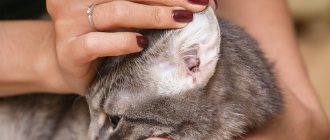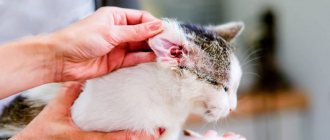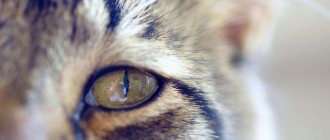By its nature, coughing is a specific reflex of a protective nature. Coughing is necessary to clear the respiratory tract. Thus, in newborn kittens, coughing serves the function of clearing mucus from the respiratory tract and allowing them to take their first breath.
The owner of the animal must clearly distinguish when a cough that appears does not pose a particular threat, and in which cases it is necessary to sound the alarm and contact a veterinarian. The owner should know what the characteristic symptoms of cough are when expectorating, as well as when a foreign body enters the respiratory tract.
It is important to know what causes and types of cough in cats exist so that, if necessary, you can distinguish between them and seek help from specialists.
How does a cat cough?
Often, by coughing, cats frighten their owners with a pose in which her body shudders, as if in convulsions, and with hoarse loud sounds escaping from the throat.
- This state of affairs is like a cat choking and unable to breathe.
- The sight is terrible, and indeed a foreign body could have gotten into the throat, but this is far from the main reason.
Just like in humans, the causes of cough in cats vary widely. Only in cats they are different. By its nature, cough is divided into reflex and symptomatic.
Reflex cough
- When a foreign body gets into the animal’s throat (food or respiratory tract). In such a situation, the cat coughs and wheezes, twists its tongue, turns its head in different directions, trying to get rid of the foreign object.
- When exposed to external irritants and allergens: smoke, pepper, flour, washing and other small powders, caustic gases: exhaust from cars, household chemicals, and even perfume.
Symptomatic cough
- Respiratory cough is caused by infectious diseases of the upper respiratory tract: bacterial, viral, fungal (bronchitis, pneumonia, rhinotracheitis, laryngitis, etc.). Such diseases are often accompanied by the following symptoms: weakness, discharge from the nose and eyes, increased body temperature. If the animal is domestic and only comes into contact with you, then the disease could well have been brought on by the soles of outdoor shoes.
- Cough caused by helminthic infestations. It occurs due to toxins that appear during the life of worms and their larvae. Helminths even appear in domestic cats if the animal is not treated with anthelminths in a timely manner. This must be done once every six months.
When a cat develops helminths, it is usually accompanied by an enlarged abdomen, a sharp decrease in appetite, lethargy, vomiting, diarrhea, the presence of mucus, blood or parasites in the feces, and an increase in temperature.
Cough in combination with other symptoms
Cough is often accompanied by other symptoms that can serve as indicators in making a diagnosis.
With a sneeze
Coughing along with sneezing is most often a sign of an incipient respiratory disease. An infection localized to the nasal passages causes the cat to sneeze and develop a runny nose. However, some of the liquid does not come out through the nose, but goes down into the throat, causing a cough.
With wheezing
Wheezing is a classic sign of feline asthma; most often they are accompanied by coughing, difficulty and rapid breathing, while the pet’s mouth remains half open.
With hairballs
“Coughing up” hairballs actually has nothing to do with coughing as such; the cat tries to regurgitate the lumps from the digestive tract, rather than expel them through the respiratory tract.
When should you contact a veterinarian?
If the condition is serious and the cat is very weakened, treatment should only be carried out under the supervision of a veterinarian, since if the helminths die massively, the animal may suffer from intoxication.
- Cough that occurs due to diseases of the heart and cardiovascular system. In this case, in addition to coughing, you may experience shortness of breath, lethargy and heavy breathing. This also requires consultation with a specialized veterinarian who understands feline cardiac diseases.
- Allergic cough. Including bronchial asthma. Caused by allergens, which were already mentioned above. This cough is quite common, since cats have a very sensitive sense of smell and are very susceptible to various allergens.
- Oncology. Cats are also susceptible to cancer. Metastases can penetrate into the lung tissue, in which case a cough occurs. This is usually an age-related disease that occurs in cats around 10 years of age. Treatment is possible both surgically and medicinally. The main thing is to seek medical help in a timely manner.
- Traumatic lesions of the throat, trachea or lung. They arise as a result of fights, falls and other traumatic blows. After which air or pus can accumulate in the chest, expanding the animal’s chest, it cannot breathe and dies from suffocation.
- Fungal diseases: blastomycosis and mycoses.
- Trichobezoars are hairballs in the stomach. Occurs due to licking. As a rule, such a cough ends in vomiting with the release of a hairball.
This list is far from complete, therefore, if a cough syndrome is detected in your pet, it is best to consult a doctor.
Since the nature of the occurrence of cough is different, the cough itself is different. To determine the cause of cough, veterinarians divide it into types.
Causes of tracheitis
The chain of causes of tracheal disease is quite easy to trace.
If tracheitis occurs against the background of acute viral respiratory diseases (ARVI), then the initial trigger can be considered insufficient effectiveness of the immune system. The length of the trachea in an adult is 10-13 cm and is located between the larynx and bronchi. The upper part of the trachea, connecting to the larynx, belongs to the upper respiratory system, and the lower part, which has branches into the bronchi, is already the lower respiratory system. With tracheitis, the inflammation process occurs in the upper part of the trachea. If the lower part of the trachea is affected, complications in the form of another disease - bronchitis - are possible.
Typically, tracheitis occurs against the background of other diseases of the respiratory system. If the problem is ignored, it can become chronic, which will bother the person for years or cause complications such as pulmonary obstruction, laryngeal stenosis (edema), severe bronchitis and pneumonia.
During epidemics, when the concentration of viruses and pathogens in the external environment goes off scale, the development of tracheitis is not uncommon. Attacking factors are infectious agents that enter the respiratory system from the outside and begin to actively act under the influence of external factors, such as cooling, other viral infections or immunodeficiency. Infection refers to viruses and bacterial flora that can easily infect the mucous membrane of the trachea without proper protection2.
In addition to viruses and bacteria, the causes of acute or chronic tracheitis are:
- Prolonged hypothermia of the body
- Prolonged exposure to cold or extremely dry air
- Inhalation of polluted air in hazardous industries
- Smoking
- Alcohol abuse
Let us separately consider another reason for the development of such a disease as tracheitis - artificial pulmonary ventilation (ALV). That is, physical damage to the trachea during intubation. After just a few hours of the procedure, dystrophic changes form in the trachea, which lead to global damage to the mucous membrane. After ventilation is stopped, the damaged trachea will remain more vulnerable to infectious agents for a long time3.
Types of cough in cats
- In terms of duration, the cough can be chronic - it lasts more than one month, sometimes lasts for years, and acute - it arises spontaneously and lasts several days.
- Based on strength, coughs are divided into weak, strong and superficial.
- Intensity: mild or hysterical, turning into vomiting.
- According to the nature of the discharge: dry cough or wet cough with mucus, blood or sputum.
- By timbre: ringing or muffled.
- By time of manifestation: seasonal, for example, in the spring, an allergic cough most often manifests itself. It happens that an animal coughs at a certain time of day in the morning or evening
- By frequency: coughing attacks occur frequently or, conversely, rarely.
Observing the animal's cough, determine its type using the above parameters. This will help the veterinarian determine the full picture of the disease and make the correct diagnosis.
Acute tracheitis
The acute form of tracheitis occurs in parallel with acute diseases of the respiratory systems located above the trachea. That is, the disease occurs suddenly and does not last long, especially with complex treatment of all affected areas of the respiratory system.
Acute tracheitis occurs in primary and secondary forms. The primary form means that the disease arose on its own. The secondary form is that tracheitis was the result of another infectious disease. The first form is extremely rare.
The following types of infections can cause infectious tracheitis:
- Bacterial – staphylococci and streptococci (bacterial tracheitis);
- Viral – all types of ARVI (viral tracheitis);
- Fungal – aspergillus, actinomycetes and candida (candidal tracheitis);
- Viral-bacterial infection (viral-bacterial tracheitis).
How to help your pet
First, calm down yourself and try to calm your pet. Frankly speaking, at home it is only possible to alleviate the condition of a sick animal.
- To do this, ventilate the room, humidify the air, but avoid drafts, so as not to harm the already sick animal.
- You can inhale warm, moist air by running hot water into the bathroom, and then leave the cat in the bathroom for a while.
Cats are very sensitive to emotions, so be sure to caress your pet, talk to him in a calm, confident tone, then the animal will understand that the owner will help him, this will alleviate the patient’s condition.
Under no circumstances should you give medications before going to the veterinary clinic; this is important for making an accurate diagnosis; besides, not knowing the exact cause of the cough can only harm the animal.
Cost of treatment for allergic bronchitis
The cost of treatment for allergic bronchitis for each patient is calculated individually, taking into account factors such as:
- degree of neglect of the pathology;
- presence of associated complications
- duration of therapy, etc.
It's cheaper with us
- Beneficial programs for annual placement, pregnancy management, medical examination and “check-up” with discounts from the price list to 25%
- Discounts for disabled people, veterans, pensioners 10%
- Discount on deposit program up to 25%
- Discounts on promotions and seasonal offers up to 50%
Veterinarian recommendations
Each diagnosis requires special treatment:
- For example, infections are treated by increasing the animal’s immunity, which in the case of an allergic cough can worsen the patient’s condition. Antihistamines are needed here. If an allergen is identified, it is advisable to completely eliminate it from the animal’s life.
- For asthma, inhalers are prescribed; if this does not help, glucocorticoids are prescribed.
- A course of antibiotics is used to treat viral infections. Cough is eliminated with the help of mucolytics and expectorants.
- Helminthiasis is treated comprehensively, and medications are taken twice to completely destroy adult worms and their offspring. Be sure to monitor the animal’s condition after such treatment; in case of dehydration and exhaustion, infusion solutions are prescribed.
- When removing a foreign body, various tissue damage is sometimes discovered. Wounds are treated with anti-inflammatory drugs, and antibiotics are prescribed if necessary.
In any case, one well-known fact should be remembered. The best treatment for cats, as well as for people, is prevention and prevention of the disease.
Symptoms and treatment of allergic bronchitis in adults
Allergic bronchitis in adults and children develops as a result of contact with an allergen, which, once in the body, provokes an inadequate immune response of the defense system. Under the influence of an irritating factor, nerve endings are excited, blood tissues expand, muscles contract, which is accompanied by a strong, dry cough, profuse lacrimation, and a disturbance in general well-being.
In order for the treatment of allergic bronchitis in children and adults to be effective and the disease not to recur, it is first necessary to determine the source of the irritation. To do this, you need to consult an allergist who, based on the results of a comprehensive diagnostic examination, will identify the allergen, prescribe treatment and a special diet. It will not be possible to completely get rid of the disease, therefore, in the presence of predisposing factors, bronchitis of an allergic nature will worsen.
Preventive actions
- The cat's bed should be in a warm room, protected from drafts, preferably near a radiator. However, cats themselves choose a warmer place to sleep, do not deny them this.
- Feeding raw meat and fish is a sure way to become infected with parasites. Therefore, such treats should be eliminated.
- Strengthen your pet's immunity: buy super-premium food or use high-quality natural products. Include vitamin and mineral supplements recommended by your veterinarian in your pet's diet.
- Visit your veterinarian periodically for a preventive examination, and promptly seek medical attention if necessary.
- Avoid contact with unfamiliar animals, regularly wash your shoes and the hallway after each walk. Cats love to roll in the dust, and there can be parasite eggs and infections and other troubles. When you return home, wash your hands before petting your cat.
- Stop smoking, it is harmful for both you and your pet. Passive smoking is fraught with stomach diseases and bronchial asthma.
- Treat your cat for worms in a timely manner and follow the vaccination schedule.
- Do not give him bones or easily damaged toys.
But if your pet happens to get sick, and you love him and sincerely want to help him, stop self-medicating and make an appointment at the veterinary clinic as soon as possible. After all, the effectiveness of treatment depends on the speed of diagnosis.
Diagnosis of tracheitis
In addition to the standard history taking, external examination, assessment of respiratory function, initial examination of the throat and auscultation using a phonendoscope, there are laboratory and instrumental diagnostic methods, as well as additional studies that can lead the doctor to tracheitis4. It is on the basis of diagnosis that the causes of tracheitis and methods of its treatment are determined.
- General and biochemical blood test. The simplest test to distinguish between viral and bacterial infections (based on C-reactive protein and other indicators)
- X-ray or radiography. The most common and familiar way to check the chest. The picture can be taken in front or side projections. The image clearly shows the lungs and trachea. Thanks to x-rays, it becomes much easier to identify signs of tracheitis and distinguish it from bronchitis or pneumonia.
- Taking and examining smears. A standard procedure in which the doctor uses a sterile cotton swab to take a swab from the mouth. Next, the material is sent to the laboratory, where all the necessary studies are carried out, identifying the pathogen and its sensitivity to antibiotics.
- Laryngotracheoscopy. The endoscope comes into play. This study is the most informative. A special tube with a camera is inserted into the larynx and trachea, thereby the doctor can visually identify characteristic features, swelling, redness, etc. and possible causes of the disease (with a viral infection there are specific changes in the organ). If the study involves the bronchi, the procedure is called tracheobronchoscopy.
- Taking sputum for analysis. In this case, the sputum of a sick person is collected and sent for bacteriological examination (microbiological examination). This procedure is used for a more comprehensive diagnosis of chronic cough to exclude other bacterial diseases (tuberculosis).
- Pharyngoscopy. The standard method is for the doctor to examine the throat using a spatula. First of all, pharyngitis is diagnosed, which makes it clear about the possible development of tracheitis.
- Rhinoscopy. The procedure is an examination of the nasal cavity. For this, an optical device is used - a rhinoscope. Rhinitis is detected as a consequence of a respiratory infection, which means progression of tracheitis is possible.
- X-ray of the sinuses. X-ray, images of which will determine the presence of sinusitis or sinusitis if they are suspected. The progression of the disease may also affect the development of inflammation in the trachea.
- Allergy tests. In rare cases, tracheitis occurs due to an allergic reaction. Allergy tests allow you to determine which allergens your body responds to. Various substances are applied to the skin; if a reaction occurs in the form of redness, itching or swelling, then the allergen has been identified.
In addition to the help of a therapist and otolaryngologist (ENT), to determine the causes and make a diagnosis, consultations with doctors such as an allergist, pulmonologist and even a phthisiatrician may be required.











